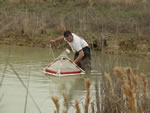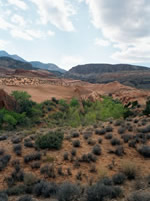Ongoing Research
Mosquito Monitoring Program
Museum and aquatic ecology personnel have been monitoring mosquito populations in the Denton, Texas area since 2001. This program begins in May and continues until November. The Texas Department of State Health Services analyzes mosquitoes collected during the survey for arboviruses.
Arthropod BioDiversity at Texas Army National Guard Bases
For three years 2002–2005 the museum personnel have been inventorying terrestrial and aquatic insects that occur at two Texas Army National Guard Bases Fort Camp Bowie, Brown Co., and Fort Wolters, Parker County. The study focused on aquatic insects, and select terrestrial insect groups. At Camp Bowie, 19 insect orders, 481 genera and 464 species of insects identified. Nine non-insect groups were also identified. A total of 14 orders of insects representing 138 families, 375 genera and 363 species were identified from Fort Wolters. We recognize that securing reliable identification to species is the greatest single difficulty in work on insect biodiversity. Except in the best known groups, expert knowledge is required to ensure that identifications are accurate. Taxonomic consultants were used to validate specific identifications reported in this study. Sampling locations, insect collection records and habitat information were summarized using ArcGIS 8.3. Once this report is approved the information will be made public. The data collected during this project is being used for graduate student research. M. Todd Jackson master’s degree thesis research is focusing on the Orthoptera at the bases. Tracee Bennett is studying the aquatic beetles as part of the requirements for her master’s thesis.
Chironomidae Associated with Springs in the Southwest Deserts
The distribution and taxonomy of the chironomid fauna of the Southwestern United States is poorly known. The study has focused on the chironomids found in springs from sites located in the Henry Mountains, Utah; Guadalupe Mountain National Park, Texas; Big Bend National Park, Texas; Love Creek Nature Preserve, Bandera, Texas; Chihuahuan Desert Research Institute, Fort Davis, Texas, and Diamond Y spring, Ft Stockton, Texas. The isolated springs we have examined contain species with curious distributions and species new to science.
The distributions observed have probably been influenced by historical geological factors. During the Pleistocene, glaciation at higher latitudes caused species immigration into our study region. This region was much wetter and cooler during this period. Climatic changes associated with the Holocene resulted in a much drier and warmer region. As these changes occurred isolated springs throughout the study area provided refugia for the chironomids resulting a high regional endemism. Losses of springs through pumping of ground water and agricultural practices associated with cattle ranching are an increasing threat to this diversity. This project is a collaborative project with Dr. Len Ferrington at the University of Minnesota.

